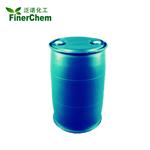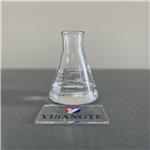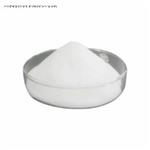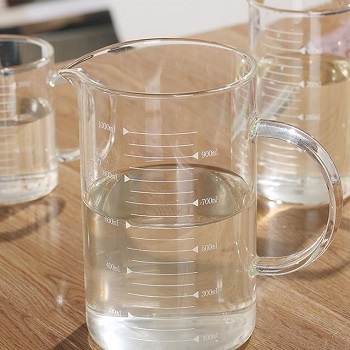- 2-Butoxyethanol
-

- $5.00 / 200kg
-
2024-04-25
- CAS:111-76-2
- Min. Order: 1kg
- Purity: 99%
- Supply Ability: 2000MT/year
- BUTOXYETHANOL
-

- $0.00 / 1kg
-
2023-11-25
- CAS:111-76-2
- Min. Order: 1kg
- Purity: 99%
- Supply Ability: 500000kg
- 2-Butoxyethanol
-

- $40.00 / 1kg
-
2023-10-07
- CAS:111-76-2
- Min. Order: 1kg
- Purity: 0.99
- Supply Ability: 10 tons
|
| | 2-Butoxyethanol Basic information |
| | 2-Butoxyethanol Chemical Properties |
| Melting point | -70 °C | | Boiling point | 171 °C | | density | 0.902 g/mL at 25 °C(lit.) | | vapor density | 4.1 (vs air) | | vapor pressure | <1 mm Hg ( 20 °C) | | refractive index | n20/D 1.419(lit.) | | Fp | 140 °F | | storage temp. | Store below +30°C. | | solubility | 900g/l completely miscible | | form | Liquid | | pka | 14.42±0.10(Predicted) | | color | Clear | | PH | 7 (H2O, 20℃)(as aqueous solution) | | Odor | Mild, characteristic; slightly rancid; mild ethereal. | | Odor Threshold | 0.043ppm | | explosive limit | 1.1-10.6%(V) | | Water Solubility | miscible | | λmax | λ: 230 nm Amax: 1.0
λ: 250 nm Amax: 0.10
λ: 275 nm Amax: 0.05
λ: 300-400 nm Amax: 0.01 | | Merck | 14,1559 | | BRN | 1732511 | | Henry's Law Constant | (x 10-6 atm?m3/mol):
2.36 (approximate - calculated from water solubility and vapor pressure) | | Exposure limits | TLV-TWA skin 25 ppm (121 mg/m3) (ACGIH), 50 ppm (242 mg/m3) (OSHA); STEL 75 ppm (363 mg/m3) (ACGIH);IDLH 700 ppm (NIOSH).
. | | Dielectric constant | 5.2999999999999998 | | LogP | 0.81 at 20℃ | | CAS DataBase Reference | 111-76-2(CAS DataBase Reference) | | IARC | 3 (Vol. 88) 2006 | | NIST Chemistry Reference | 2-n-Butoxy-1-ethanol(111-76-2) | | EPA Substance Registry System | Ethylene glycol monobutyl ether (111-76-2) |
| Hazard Codes | Xn | | Risk Statements | 20/21/22-36/38 | | Safety Statements | 36/37-46 | | RIDADR | 1986 | | WGK Germany | 1 | | RTECS | KJ8575000 | | Autoignition Temperature | 473 °F | | TSCA | Yes | | HS Code | 2909 43 00 | | HazardClass | 6.1 | | PackingGroup | III | | Hazardous Substances Data | 111-76-2(Hazardous Substances Data) | | Toxicity | LD50 orally in rats: 1.48 g/kg (Smyth) | | IDLA | 700 ppm |
| | 2-Butoxyethanol Usage And Synthesis |
| Description | 2-Butoxyethanol is a clear, colourless liquid with ether-like smell.2-Butoxyethanol is usually
produced by a reaction of ethylene oxide with butyl alcohol, but it may also be made by
the reaction of ethylene glycol with dibutyl sulphate. 2-Butoxyethanol is widely used as a
solvent in protective surface coatings such as spray lacquers, quick-dry lacquers, enamels,
varnishes, and latex paints. It is also used as an ingredient in paint thinners and strippers,
varnish removers, agricultural chemicals, herbicides, silicon caulks, cutting oils, and
hydraulic fluids and as metal cleaners, fabric dyes and inks, industrial and household
cleaners (as a degreaser), and dry-cleaning compounds. It is also used in liquid soaps and
in cosmetics.
2-Butoxyethanol acetate has been reported to be present in air, water, and soil as a contaminant
and exposure to it occurs during its manufacture and use as an intermediate
in the chemical industry, and during the formulation and use of its products in multiple
industrial activities. The acetate form of 2-butoxyethanol is 2-butoxyethanol acetate and
also known as ethylene glycol monobutyl ether acetate. | | Chemical Properties | 2-Butoxyethanol is a clear colorless liquid with an ether-like smell and belongs to the family of glycol ether/alkoxy alcohol. 2-Butoxyethanol is miscible in water and soluble in most organic solvents. 2-Butoxyethanol does not occur naturally. It is usually produced by reacting ethylene oxide with butyl alcohol.

2-Butoxyethanol is used as a solvent for nitrocellulose, natural and synthetic resins, soluble oils, in surface coatings, spray lacquers, enamels, varnishes, and latex paints, as an ingredient in paint thinners, quick-dry lacquers, latex paint, and strippers, varnish removers, and herbicides. It is also used in textile dyeing and printing, in the treatment of leather, in the production of plasticizers, as a stabilizer in metal cleaners and household cleaners, and in hydraulic fl uids, insecticides, herbicides, and rust removers. It is also used as an ingredient in liquid soaps, cosmetics, industrial and household cleaners, dry-cleaning compounds, and as an ingredient in silicon caulks, cutting oils, and hydraulic fluids. 2-Butoxyethanol is a fire hazard when exposed to heat, sparks, or open flames. | | Physical properties | Clear, colorless, oily liquid with a mild, ether-like odor. Experimentally determined detection and
recognition odor threshold concentrations were 500 μg/m3 (100 ppbv) and 1.7 mg/m3 (350 ppbv),
respectively (Hellman and Small, 1974). An odor threshold concentration of 580 ppbv was
reported by Nagata and Takeuchi (1990). | | Uses | Ethylene glycol monobutyl ether (EGBE) is used as a solvent for nitrocellulose, resins, oil, and grease, and in dry cleaning. | | Uses | Ethylene glycol n-butyl ether (EB) is used widely as a coupling solvent because of
its superior coupling efficiency and excellent solvency for resins. | | Uses | 2-Butoxyethanol is a reagent in the synthesis of 4-butoxyethoxy-N-octadecyl-1,8-naphthalimide as a new fluorescent probe for the determination of proteins. Also used as a reagent in the synthesis of 4-hydroxybenzaldehyde derivatives as tyrosinase inhibitors. | | Uses | Solvent for nitrocellulose, resins, grease, oil, albumin; dry cleaning. | | Definition | ChEBI: 2-butoxyethanol is a primary alcohol that is ethanol in which one of the methyl hydrogens is replaced by a butoxy group. A high-boiling (171℃) colourless liquid, it is used as a solvent for paints and inks, as well as in some dry cleaning solutions. It has a role as a protic solvent. It is a primary alcohol and a glycol ether. | | Synthesis Reference(s) | The Journal of Organic Chemistry, 45, p. 1095, 1980 DOI: 10.1021/jo01294a034 | | General Description | A colorless liquid with a mild, pleasant odor. Less dense than water. Flash point 160°F. Irritates skin and eyes and may be toxic by ingestion. Used as a solvent and to make paints and varnish. | | Air & Water Reactions | 2-Butoxyethanol is sensitive to air and light. Slightly soluble in water. | | Reactivity Profile | ETHYLENE GLYCOL N-BUTYL ETHER may react with bases, aluminum and oxidizing materials. 2-Butoxyethanol is liable to form peroxides on exposure to air and light. 2-Butoxyethanol attacks some forms of plastics, rubber and coatings. . | | Hazard | A toxic material. Eye and upper respiratory
tract irritant. Questionable carcinogen. | | Health Hazard | 2-Butoxyethanol is present in a variety of consumer products, including cleaning
agents and surface coatings, such as paints, lacquers, and varnishes. 2-Butoxyethanol
is readily absorbed following inhalation, oral, and dermal exposure. 2-Butoxyethanol
is released into air or water by different industrial activities and facilities that manu facture, process, or use the chemical. Exposure to 2-butoxyethanol causes irritating
effects to the eyes and skin, but it has not induced skin sensitization in guinea pigs.
Information on the human health effects associated with exposure to 2-butoxyethanol
is limited. However, case studies of individuals who had attempted suicide by ingest ing 2-butoxyethanol-containing cleaning solutions suffered poisoning with symp toms such as hemoglobinuria, erythropenia, and hypotension, metabolic acidosis,
shock, non-cardiogenic pulmonary edema, and albuminuria, hepatic disorders and
hematuria. | | Fire Hazard | Combustible material: may burn but does not ignite readily. Containers may explode when heated. Runoff may pollute waterways. Substance may be transported in a molten form. | | Chemical Reactivity | Reactivity with Water No reaction; Reactivity with Common Materials: No reaction; Stability During Transport: Stable; Neutralizing Agents for Acids and Caustics: Not pertinent; Polymerization: Not pertinent; Inhibitor of Polymerization: Not pertinent. | | Safety Profile | Poison by ingestion,
skin contact, intraperitoneal, and
intravenous routes. Moderately toxic via
inhalation and subcutaneous routes. Human
systemic effects by inhalation: nausea or
vomiting, headache, unspecified eye effects.
Experimental teratogenic and reproductive
effects. A skin irritant. Combustible liquid
when exposed to heat or flame. To fight
fire, use foam, CO2, dry chemical.
Incompatible with oxidizing materials, heat,
and flame. When heated to decomposition it
emits acrid smoke and irritating fumes | | Potential Exposure | 2-Butoxy ethanol is a colorless liquid with a
mild, ether like odor. Molecular weight 5 118.20; Specific
gravity (H2O:1) 5 0.90; boiling point 5 171�C; freezing/
melting point 5 274.8�C; vapor pressure 5 0.8 mmHg @
20�C; Relative vapor density (air 5 1) 5 4.1; Flash
point = 61�C (cc); Autoignition temperature = 238�C | | First aid | If this chemical gets into the eyes, remove anycontact lenses at once and irrigate immediately for at least15 min, occasionally lifting upper and lower lids. Seek medical attention immediately. If this chemical contacts theskin, remove contaminated clothing and wash immediatelywith soap and water. Seek medical attention immediately. Ifthis chemical has been inhaled, remove from exposure,begin rescue breathing (using universal precautions, including resuscitation mask) if breathing has stopped and CPR ifheart action has stopped. Transfer promptly to a medicalfacility. When this chemical has been swallowed, get medical attention. Give large quantities of water and inducevomiting. Do not make an unconscious person vomit.Medical observation is recommended for 24� 48 h afterbreathing overexposure, as pulmonary edema may bedelayed. As first aid for pulmonary edema, a doctor orauthorized paramedic may consider administering a corticosteroid spray. | | Environmental fate | Biological. Bridié et al. (1979) reported BOD and COD values of 0.71 and 2.20 g/g using
filtered effluent from a biological sanitary waste treatment plant. These values were determined
using a standard dilution method at 20 °C for a period of 5 d. When a sewage seed was used in a
separate screening test, a BOD value of 0.20 g/g was obtained. The ThOD for 2-butoxyethanol is
2.31 g/g.
Chemical/Physical. At an influent concentration of 1,000 mg/L, treatment with GAC resulted
in an effluent concentration of 441 mg/L. The adsorbability of the carbon used was 112 mg/g
carbon (Guisti et al., 1974). | | storage | 2-Butoxyethanol should be kept stored in tightly closed, grounded containers in a cool area
with adequate ventilation, away from normal work areas and sources of heat and sparks,
and electrical equipment. At the storage and handling area, workers should use solvent resistant materials. | | Shipping | Toxic, liquids, organic, n.o.s., or Ethylene glycolmonobutyl ether require a shipping label of “POISONOUS/TOXIC MATERIALS.” It falls in Hazard Class 6.1 andPacking Group III. | | Purification Methods | Peroxides can be removed by refluxing with anhydrous SnCl2 or by passage under slight pressure through a column of activated alumina. Dry with anhydrous K2CO3 and CaSO4, filter and distil, or reflux with, and distil from NaOH. [Beilstein 1 IV 2380.] | | Incompatibilities | May form explosive mixture with air.
Can form unstable and explosive peroxides; check for peroxides prior to distillation; render harmless if positive.
Decomposes, producing toxic fumes. Violent reaction with
strong caustics and strong oxidizers. Attacks some coatings,
plastics and rubber. Attacks metallic aluminum at high
temperatures. | | Waste Disposal | EGBE is destroyed by burning in an incinerator. In the laboratory, small amounts may be disposed of in the sink with a large volume of water. | | Precautions | Occupational workers should use minimal quantities of 2-butoxyethanol in designated
areas with adequate ventilation and away from sources of heat or sparks. Whenever pos sible, fi re-resistant containers should be used. Wear appropriate protective equipment to
prevent skin and eye contact. |
| | 2-Butoxyethanol Preparation Products And Raw materials |
|